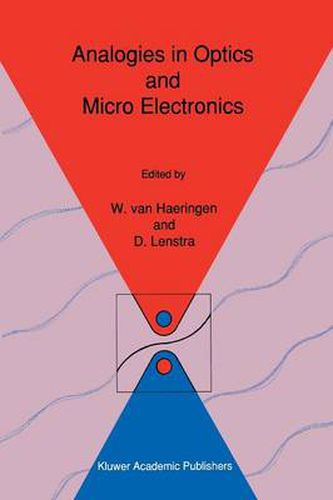Readings Newsletter
Become a Readings Member to make your shopping experience even easier.
Sign in or sign up for free!
You’re not far away from qualifying for FREE standard shipping within Australia
You’ve qualified for FREE standard shipping within Australia
The cart is loading…






This title is printed to order. This book may have been self-published. If so, we cannot guarantee the quality of the content. In the main most books will have gone through the editing process however some may not. We therefore suggest that you be aware of this before ordering this book. If in doubt check either the author or publisher’s details as we are unable to accept any returns unless they are faulty. Please contact us if you have any questions.
This book gives an account of a number of recent developments in two different subfields of research, optics and micro–electronics. The leading principle in presenting them together in one book is the striking similarity between a variety of notions in these two research areas. We mention in this respect tunneling, quantum interference and localization, which are important concepts in quantummechanics and more specifically in condensed matter physics. Miniaturization in solid state engineering has led to new phenomena in which these concepts play their significant roles. As it is the wave character of electrons which is strongly emphasized in these phenomena one’s attention is quite naturally directed to the field of optics in which the above quantum-mechanical notions all seem to have their direct classical wavemechanical counterparts. Both micro–electronics and optics have been and still are in a mode of intensifying activity. The possibilities to technically translate devices developed within one research field to similar devices in the other field are strongly increasing. This opens, among other things, a door leading to quantummechanics on a macroscopic scale with visible light under relatively easily accessible experimental conditions, or to wave optics II in the domain of solid state physics. Thinking in terms of analogies is important anyhow, but it is especially the cross-fertilization between optics and micro–electronics which according to the editors will lead to deepened insights and a new type of technology.
$9.00 standard shipping within Australia
FREE standard shipping within Australia for orders over $100.00
Express & International shipping calculated at checkout
This title is printed to order. This book may have been self-published. If so, we cannot guarantee the quality of the content. In the main most books will have gone through the editing process however some may not. We therefore suggest that you be aware of this before ordering this book. If in doubt check either the author or publisher’s details as we are unable to accept any returns unless they are faulty. Please contact us if you have any questions.
This book gives an account of a number of recent developments in two different subfields of research, optics and micro–electronics. The leading principle in presenting them together in one book is the striking similarity between a variety of notions in these two research areas. We mention in this respect tunneling, quantum interference and localization, which are important concepts in quantummechanics and more specifically in condensed matter physics. Miniaturization in solid state engineering has led to new phenomena in which these concepts play their significant roles. As it is the wave character of electrons which is strongly emphasized in these phenomena one’s attention is quite naturally directed to the field of optics in which the above quantum-mechanical notions all seem to have their direct classical wavemechanical counterparts. Both micro–electronics and optics have been and still are in a mode of intensifying activity. The possibilities to technically translate devices developed within one research field to similar devices in the other field are strongly increasing. This opens, among other things, a door leading to quantummechanics on a macroscopic scale with visible light under relatively easily accessible experimental conditions, or to wave optics II in the domain of solid state physics. Thinking in terms of analogies is important anyhow, but it is especially the cross-fertilization between optics and micro–electronics which according to the editors will lead to deepened insights and a new type of technology.